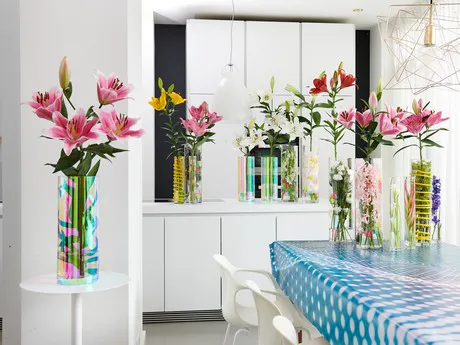The lily comes in serene white and calm pink, but also in eye-catching red, yellow, purple and orange. With stripes, fringes or spots if preferred. With flowers that can be both trumpet-shaped or shaped like a bowl, the flowers can reach a diameter of 25 cm, and most smell like an oriental garden on a warm evening.

Credit: Funnyhowflowersdothat.co.uk
Energy and balance
The lily has been chosen as the flower of the month for June because it’s available in colours - pink, white, yellow - that fit well with the New Frontiers style trend. Think of smart technology in the home where flowers make a subtle reference to nature combined with shiny, clear glass and iridescent materials.
Origin
Lilies are not only varied in terms of colour, shape and size, but also where they come from. You can find them growing wild in Korea, Japan and parts of Siberia, but also close to the equator in India. In Europe the lily is native to the Caucasus, the Balkans, Greece, Poland, the Alps and Pyrenees. It also grows wild in most American states, with the exception of the south-west parts of the United States.
Range
Bright and soft colours, freckles, flames or spots and a large variety of flower shapes both scented and scentless make the lily range very varied.
- The older generation is the Asiatic Group with plain colours, lots of buds, small flowers, more delicate leaves and stamens that give off pollen.
- The Oriental Group features the most colours in white and pink or bi-coloured, has larger buds and flowers, coarser leaves, heavier stems and is strongly scented.
- The most traditional group is the Lilium Loingflorum Group with coarser leaves and a trumpet-shaped flower. Most of the cultivars are white, but there are also red and pink cultivars. Lilies from the Lilium Longiflorum Grp, which means ‘having long flowers’, have a light fragrance and are mainly white.
- Crossing the Longiflorum and Asiatic lily has resulted in the LA Group. These feature pale pastels shades, compact branching, coarser leaves and stamens that give off pollen. The lilies in the cut flower range are crosses of various species.
- A fairly new addition are the double-flowered Oriental lilies that are offered under the name Roselily and are pollen-free. The Lilium Martagon Grp, the Turkish lily, with many small spotted flowers on a stem is also a new addition to the cut flower range.
Inspiration & information
Inspiring images of every flower on the Flower Agenda have been produced in line with the Horticulture Sector Trends 2019 (Groenbranche Trends 2019). These trends are a translation of the latest consumer trends and are specifically aimed at the horticulture sector for use both indoors and outdoors.
For more information:
www.flowercouncil.co.uk
